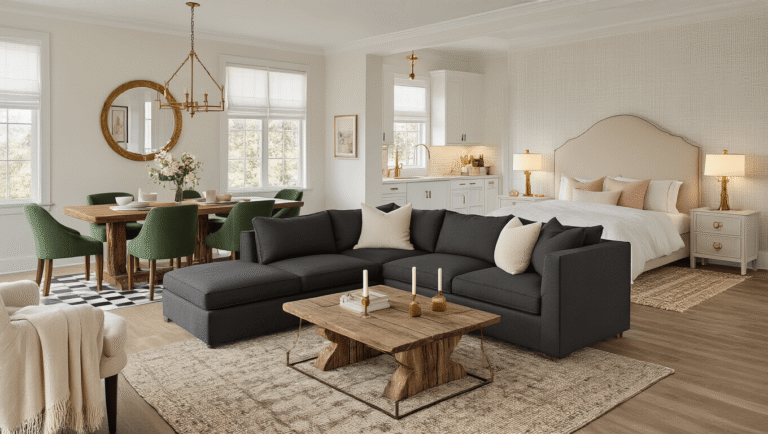This post may contain affiliate links. Please see my disclosure policy for details.
The Science Behind Why We Crave Cozy Spaces
Contents
Your brain is hardwired to seek comfort and safety. When you walk into a truly cozy room, your nervous system literally relaxes.
Biophilia plays a huge role here. This fancy term simply means humans feel naturally drawn to nature. When you incorporate natural materials like wood, stone, or wicker into your space, you’re tapping into this ancient instinct.
I discovered this firsthand when I added a rustic wooden coffee table to my living room. Suddenly, the entire space felt more grounded and peaceful.
The psychological impact of enclosed, softly lit spaces can’t be overstated either. Think about it – caves protected our ancestors, and we still crave that sense of enclosure today.
Master the Art of Warm Lighting (Your Secret Weapon)
Here’s what nobody tells you about lighting: it’s doing 80% of the heavy lifting in creating atmosphere.
Ditch the harsh overhead lights immediately.
I learned this lesson the hard way when I hosted a dinner party under fluorescent bulbs. Everyone looked like they belonged in a hospital waiting room.
The Lighting Game Plan:
- Use warm-toned bulbs (2700-3000K) – these mimic the golden hour
- Layer different light sources – table lamps, floor lamps, candles
- Create pools of light instead of flooding the entire room
- Add dimmer switches for ultimate control
I now have at least three light sources in every room. My go-to setup includes a soft table lamp, some candles, and string lights for extra magic.
Pro tip: Cluster lighting in groups of three. One lamp looks lonely, but three creates visual interest and better illumination.
Texture Layering: The Make-or-Break Element
If lighting is your secret weapon, texture layering is your superpower.
I used to have a living room that looked great in photos but felt cold and uninviting. The problem? Everything was smooth and uniform.
Your Texture Toolkit:
- Chunky knit throws for instant coziness
- Velvet pillows for luxury you can touch
- Woven rugs to anchor your space
- Natural fiber baskets for stylish storage
- Brushed metals for subtle shine
The key is mixing different textures in the same color family. I layer a wool blanket over a linen sofa, add some velvet cushions, and place everything on a jute rug.
Start with three textures and build from there.
Create Intimate Furniture Groupings (Not Furniture Jail)
The biggest mistake I see people make? Pushing all their furniture against the walls like they’re afraid it might escape.
Furniture should create conversation areas, not obstacles.
The Foolproof Formula:
- Group seating within 8 feet of each other
- Create multiple seating areas in larger rooms
- Use side tables within arm’s reach of every seat
- Add plants or lamps to fill awkward corners
I completely transformed my living room by pulling my sofa away from the wall and creating a tight seating arrangement around a cozy area rug.
The result? Instant intimacy and better conversation flow.
The Color Psychology of Comfort
Colors have moods, and harsh whites scream “sterile” not “cozy.”
Embrace the power of warm, muted tones.
I spent years fighting against beige, thinking it was boring. But when I finally embraced warm neutrals, everything clicked.
Colors That Actually Create Coziness:
- Warm browns and taupes – like a hug in color form
- Soft creams and off-whites – sophisticated without being stark
- Muted greens – bringing nature indoors
- Deep navy blues – cozy without being dark
- Terracotta and rust – earthy warmth
The secret: Use varied shades of your chosen color to prevent flatness.
If you’re going for warm brown, include everything from mushroom to chocolate. This creates depth and visual interest without being overwhelming.
Personal Touches That Actually Matter
Here’s where most design advice goes wrong. They tell you to add “personal touches” but never explain what that means.
Personal doesn’t mean cluttered.
What Actually Works:
- Books you’ve actually read (not just pretty spines)
- Plants you can keep alive – start with pothos or snake plants
- Art with stories – your grandmother’s painting beats generic prints
- Handmade items – that pottery class bowl, your friend’s knitted scarf
- Photos in frames – not just stuck to the fridge
I have a small shelf dedicated to travel souvenirs. Not touristy junk, but meaningful pieces like a hand-carved wooden bowl from Morocco and a vintage postcard from Paris.
Each item has a story, and that emotional connection is what makes a space truly yours.













[…] 2 upholstered end chairs for a cozy captain’s seat feel […]